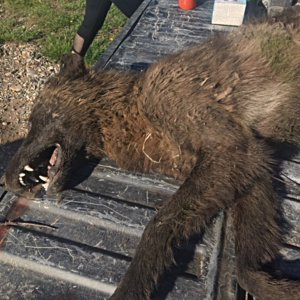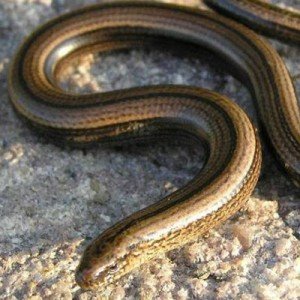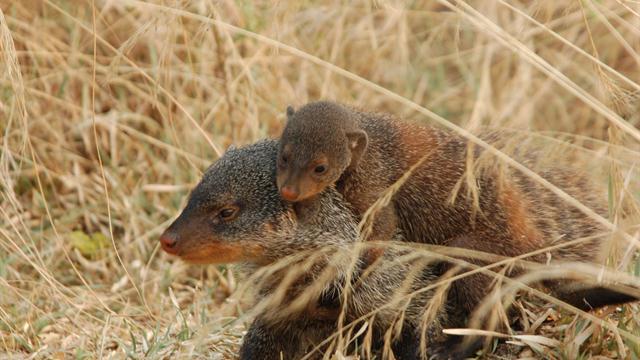TERMITES CHAPTER 2
Termite mounds, like this one in Namibia, contain a series of bubble-like chambers connected by branching passages.
PHOTOGRAPH BY FRANTISEK STAUD, NATIONAL GEOGRAPHIC
For the past 26 years, J. Scott Turner has filled termite mounds with propane, scanned them with lasers, and stuffed them with plaster. He has fed microscopic beads to termites, given the insects fluorescent green water, and even tried to turn termite behavior into a video game.
A professor of animal physiology at the SUNY College of Environmental Science and Forestry in Syracuse, this rangy intellectual MacGyver does it all in search of clues to a biological mystery: How do tiny termites build such spectacular structures?
A single termite can be barely bigger than the moon of a fingernail, its semi-transparent exoskeleton as vulnerable to sunlight as to being crushed by a child in flip-flops. But in groups of a million or two, termites are formidable architects, building mounds that can reach 17 feet (5 meters) and higher. The 33 pounds (15 kilograms) or so of termites in a typical mound will, in an average year, move a fourth of a metric ton (about 550 pounds) of soil and several tons of water.
The termites also "farm" a symbiotic fungus that occupies eight times more of the nest than the insects do. And some termites eat as much grasseach year as an 880-pound (400-kilogram) cow.
Like ants, bees, and other social insects, termites live in societies where the collective power of the colony far outstrips that of the individual. Being part of a super-organism gives the tiny termite superpowers. But a termite mound is like a construction site without a foreman—no one termite is in charge of the project. Is there a "collective plan" encoded in the collective mind of the colony? That question has obsessed Turner for years.
In addition to experimenting in the mounds, Turner designs computer simulations to explore deeper patterns in termite behavior. It wouldn't be wrong to say he's been searching for the psyche of the super-organism, but it wouldn't fully get at the richness of all of the other things he's noticed along the way—including clues to how humans might build more energy-efficient buildings, how we might design robots to build on places like Mars, and even peculiar termite behaviors that might help us understand how our own brains work.
Termites communicate with each other using touch and vibrations.
PHOTOGRAPH BY MARK W MOFFETT, NATIONAL GEOGRAPHIC
Always Ready to Rebuild
Turner pursues his fieldwork amid the semiarid savannas of northern Namibia, on a government-owned research station named Omatjenne—the word for lightning in the local Herero language. Sure enough, on an afternoon tour of the farm, the horizon is loaded with fat, dark clouds that are soon gashed by electricity.
The life of the termite is a race against rain, Turner says. Termite mounds can take four to five years to build, but a really heavy downpour might cause a third of the mounds to collapse. So termites are always scurrying to rebuild their mounds as fast as the weather erodes them.
To demonstrate the rebuilding process, Turner uses an auger, a tool that looks like a big corkscrew, to cut into the rock-hard surface of a mound. As he pulls a six-inch (15-centimeter) plug of dirt from the side, termites pour out of the hole. Soldiers fan out with their pinching mandibles ready for battle, and workers with mouths full of dirt run to plug the hole. How do they know there's a hole in the mound?
Termites are "novelty detectors," attuned to excitement and always on alert, says Turner. (When there isn't external stimulation, termites sometimes stand in little clusters, massaging each other's antennae.) Experiments in Turner's lab suggest they respond to slight air movements and changes in humidity and concentrations of gases like carbon dioxide.
At the first sign of a disturbance, a termite runs to communicate the news with touch and vibrations. Roused, masses of termites fill their mouths with dirt and head toward the source of the problem. The commotion attracts more termites with more dirt, and within an hour or so the hole is patched.
Scott Turner peers into a plaster cast of a termite mound to ponder its architecture.
PHOTOGRAPH BY MARK W. MOFFETT, NATIONAL GEOGRAPHIC
Peering Inside
The only way to get a glimpse of the termite super-organism in action is to rip the side off a mound. And so one morning Turner, along with entomologist Eugene Marais of the National Museum of Namibia, takes a backhoe to the test fields. With a single swoop, the backhoe removes the top of a mound and then precisely dismantles the rest, like pulling the walls off a dollhouse.
The termites are not happy that their walls have suddenly disappeared, and they swarm frantically around the exposed structure. Marais dislodges a chunk of dense soil about the size of a squashed soccer ball—the queen's chamber.
After repeated blows of a hand pick, the capsule breaks open suddenly, revealing a saucer about five inches (almost 13 centimeters) across containing the queen. Her sweating body is swollen to the size of a human finger. A coterie of workers carries the eggs she produces—at the staggering rate of one every three seconds—to nearby nurseries, while others feed and clean her.
The queen herself, once a relatively normal size, retains her original legs, but they are now nearly useless. Her pale body pulsates, the caramel-colored fats and liquids inside swirling under her skin.
The title "queen" leads people to imagine that she is in charge of the mound, but this is a misconception. "The queen is not in charge," says Marais. "She's really a slave." The queen is the epitome of the super-organism: one for all and all for one. She is a captive ovary, producing hundreds of millions of eggs over her life span of up to 15 years to populate the mound.
Termites rebuild their mounds with mouthfuls of dirt when they're damaged or the weather erodes them.
PHOTOGRAPH BY MARK W. MOFFETT, NATIONAL GEOGRAPHIC
Farming Fungus
Below the queen's chamber lies the super-organism's largest organ: the fungus garden. In a symbiotic relationship dating back millions of years, the termites exit the mound through long foraging tunnels and return with their "intestines full of chewed grass and wood, which they defecate upon their return, and other workers assemble these 'pseudo-feces' into several mazelike fungus combs," Turner explains.
The termites then seed the comb with spores of fungus, which sprout and dissolve the tough cellulose into a high-energy mixture of partially digested wood and grass. For the termites, the fungus functions as a sort of external stomach, but the fungus gets the better deal. Ensconced in elaborate termite-built combs and constantly tended, the fungus receives multiple benefits, including food, water, shelter, and protection.
In fact, the deal is so lopsided that it calls into question just who's in charge of the relationship. Collectively, the colony's fungus accounts for nearly 85 percent of the total metabolism inside the mound, and Turner speculates that the fungus may send chemical signals to the termites that influence—control?—the way they build the mound. "I like to tell people that this may not be a termite-built structure," he says. "It may actually be a fungus-built structure."
The collective power of the termite colony far outstrips that of the individual.
PHOTOGRAPH BY MARK W. MOFFETT, NATIONAL GEOGRAPHIC
Living Quarters
Which brings us to the most extraordinary organ: the mound itself. Contrary to common notions, termite mounds are not high-rise residence halls. Rather, they are "accessory organs of gas exchange," in Turner's words, designed to serve the respiratory needs of the subterranean colony located several feet (a meter or two) below the mound.
For many years, researchers looked at termite mounds and supposed that the spires worked like chimneys, drawing hot air up and out. But Turner discovered that mounds function more like lungs, inhaling and exhaling through walls that appear impenetrable but are actually quite porous.
Inside the mound, a series of bubble-like chambers connected to branching passages absorb changes in outside pressure or wind and pass them through the mound. To regulate the mix of gases and maintain a stable nest environment, the termites are forever remodeling the mound in response to changing conditions.
"A termite mound is like a living thing," says Turner, "dynamic and constantly maintained."
The queen (top right) produces hundreds of millions of eggs over her life span of up to 15 years to populate the mound.
PHOTOGRAPH BY MARK W. MOFFETT, NATIONAL GEOGRAPHIC
Wet Kisses
While studying termite building behavior, Turner noticed that his subjects seemed to be kissing each other, mouth to mouth, after a complicated ritual that included grooming and begging. Curious, he added fluorescent green dye to their water and discovered that all this "kissing" was actually a bucket brigade, transferring large amounts of water across the mound. A termite can drink half its own weight in water, scurry to a drier part of the mound, and distribute it to other termites. In addition to rebalancing the mound's moisture level, moving all of this water dramatically changes its shape.
Turner's work with termites has attracted some notable collaborators, among them British engineer Rupert Soar. Inspired in part by termite mounds, Soar has plans to build energy-efficient houses with porous walls that make use of passive wind energy. He's also looked into using termite-style building methods to help robots build structures in remote locations using only local materials.
Turner added fluorescent green dye to termites' water to illuminate how they transfer large amounts of water across the mound.
PHOTOGRAPH BY MARK W. MOFFETT, NATIONAL GEOGRAPHIC
Group Brain
Termites may even change the way we think about thinking. A research project at Harvard's Wyss Institute for Biologically Inspired Engineeringbrought computer scientists and roboticists to Turner's site to observe termite behavior with a range of sophisticated scanners and software.
Harvard professor of robotics Radhika Nagpal makes an analogy between the behavior of termites and the brain. Individual termites react rather than think, but at a group level they exhibit a kind of cognition and awareness of their surroundings. Similarly, in the brain, individual neurons don't think, but thinking arises in the connections between them. (Single neurons, for example, may recognize a baseball bat and the smell of hot dogs, but working in concert they let you know you're at a baseball game.)
Nagpal's team set up dozens of experiments to try to observe just where this collective cognition arose. "What program are they running?" mused Harvard physicist Justin Werfel, comparing the termites to robots. "Can we get a stochastic model of a stateless automaton that has no memory but reacts to what it encounters?"
Nagpal, Werfel, and Kirstin Peterson, also from Harvard, recently used termite behavior as a model to build a small swarm of robots (named TERMES) that assembles a structure without any instructions.
"This is a system where complexity is of the essence," Turner says of the termites' behavior. "If you don't capture the complexity, there's no hope of understanding it." And so the quest continues for the elusive mind in the mound.
Lisa Margonelli is a senior research fellow at the New America Foundation and the author of Oil on the Brain: Petroleum's Long, Strange Trip to Your Tank. She is working on a new book about termites.
Copyright © 1996-2015 National Geographic Society.
Copyright © 2015-2018 National Geographic Partners, LLC. All rights reserved
Copyright © 2015-2018 National Geographic Partners, LLC. All rights reserved









Comments
Post a Comment